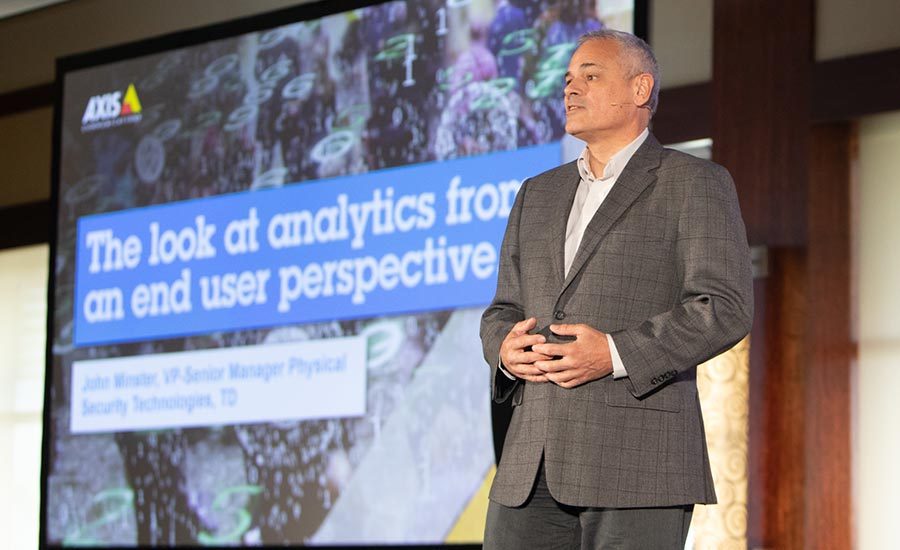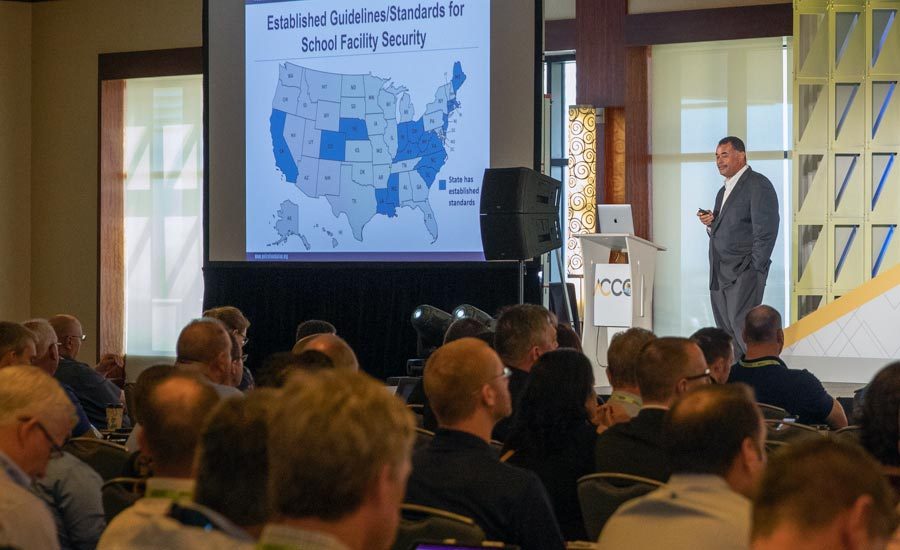The Purpose of Innovation: A Focus on Industry-Wide Solutions at Axis Communications Partner Event

Video analytics are helping TD Bank monitor for vagrants sleeping in bank branch vestibules. Getting accurate analytics is a challenge, says John Minster, VP and Senior Manager, Physical Security Technologies, TD Bank, so he worked for more than a year with Axis Communications to build a solution that fit TD Bank’s specific need. Photo by Luis Arturo Mora Neuville, courtesy of Axis Communications

States currently have more recommendations than requirements for school security, but both are still low, says Robert Boyd, Executive Director of the Secure Schools Alliance, at the annual Axis Communications partners’ conference held last month in Fort Lauderdale, Florida. Photo by Luis Arturo Mora Neuville, courtesy of Axis Communications

Troy Galloway (left) of Renew Atlanta and SPO Thomas Sutton Jr. of the Atlanta PD outline how they’re leveraging public-private partnerships within the City of Atlanta to improve traffic flow and pedestrian safety as well as share resources to assist police. Photo by Luis Arturo Mora Neuville, courtesy of Axis Communications

Ross Bourgeois (left), New Orleans Real Time Crime Center Administrator, and George Brown, RTCC IT Manager, explain how federated camera views and partnerships with city residents and businesses are helping to improve police response and increase efficiency for not only law enforcement but sanitation and water management as well. Photo by Luis Arturo Mora Neuville, courtesy of Axis Communications




“What is the ultimate goal of innovation?” asks Fredrik Nilsson, Vice President of the Americas, Axis Communications. His answer: bringing value to the entire security ecosystem – from other manufacturers to dealers to integrators to end users.
Last month, the 13th annual Axis Communications partner event – commonly called ACCC among the 350+ attendees – focused on education, networking and inspiration for attendees, with discussions and sessions on security talent acquisition and retention, security standards, unconventional security installations (such as how to utilize audio monitoring in healthcare to reduce the amount of in-person patient room monitors needed), cybersecurity (from product offerings and support solutions to how to drive the conversation between integrators and end users on cyber responsibilities) and more.
In the opening keynote, the five dimensions of innovation were outlined:
- Human – including advocating for more diversity in the security industry and preparing for a new generation of security leaders.
- Technology – including investment in cybersecurity. As Axis Senior Director of Business Development, Solutions and Services, Scott Dunn says: “In the face of current threats, everyone in his room needs to up their cybersecurity capabilities.”
- New Markets – bringing security applications to new areas and technology ranges, such as audio, perimeter monitoring and more.
- Service – providing free and easily accessible tools and customer service for all levels of the ecosystem, from partners to customers.
- Social Responsibility – participating in volunteer work (such as with Mission 500, an organization that supports children in need; ACCC attendees helped pack backpacks to be donated to homeless children in Florida at the event) and being environmentally conscious helps to improve a company’s footprint and morale while attracting younger talent.
From there, the conference frequently returned to its theme of being a good partner to the ecosystem and the industry, asking how can manufacturers better tailor their services to their dealers’ and integrators’ needs, and how can every level of the security industry stay attuned to the needs of the end user.
On that note, ACCC featured multiple keynotes from end users and industry advocates, who outlined both successful installations and upcoming challenges.
Robert Boyd, Executive Director of the Secure Schools Alliance, explained the shifting landscape of school security recommendations and regulations, particularly where security technology and funding is involved. Only 17 states have established standards for school facility security, he says, and only 11 states provide grants for school security.
What does the security industry need to bring to the table? Innovation – Boyd says that R&D from manufacturers and industry partners will help solve problems specific to school security while still respecting fire and safety code and other regulations.
Innovation is playing a large role within the City of Atlanta as well. Troy Galloway from Renew Atlanta showed how by feeding information from city surveillance cameras back into an adaptive traffic control system, the city can adjust signal times for incoming cars and pedestrians, helping to improve traffic flow in some of the city’s busiest corridors.
SPO Thomas Sutton, Jr. with the Atlanta PD gave an update on Operation SHIELD, which serves as a force multiplier for police within the city by federating thousands of privately-owned cameras around Atlanta. Police cars are now equipped with 4G hotspots, so Video Integration Center operators can send over camera feeds and information during a dispatch so the officers are equipped with as much information about the situation as possible before arriving.
Regarding partner collaborations, Sutton says that it’s essential for integrators and vendors to communicate their solutions’ realistic capabilities and address the user’s expectations, to pool common resources or search for additional sources of support or partners in the area, and to establish an IT point of contact (besides the corporate representative) to get a second opinion on whether the proposed technology is a good fit for the end user’s network and infrastructure.
Also seeking to expand police coverage and situational awareness, representatives from the City of New Orleans’ Real Time Crime Center (RTCC) – George Brown and Ross Bourgeois – explained how establishing the center expanded the number of cameras on tourism hotspot Bourbon Street helped to increase police efficiency.
Like many cities, New Orleans is facing a police officer recruitment and retention challenge, so they needed an artificial force multiplier. By adding around 240 cameras through five phases of deployment, as well as a fully staffed Crime Center to review camera feeds after an emergency call and send the information to police officers to help streamline response by giving timely details, like a description and plate number for a car involved in an accident, or a description of a person fleeing an area.
“We’re giving (police officers) man hours back, and it’s up to the police department to use them wisely,” says Bourgeois, RTCC Administrator.
The cameras are not used just for crime response, however; they’re also in use to monitor for flood levels on city streets or to help with anti-illegal-dumping campaigns.
From a banking and finance perspective, John Minster, VP and Senior Manager, Physical Security Technologies for TD Bank, recommended that manufacturers and integrators look at video analytics from an end user’s (and their C-suite’s) perspective – address any misconceptions about system capabilities early, and strive to find or build solutions that fit the user’s needs.
“You’re either part of change or you’re part of history – make your choice,” Minster says.



